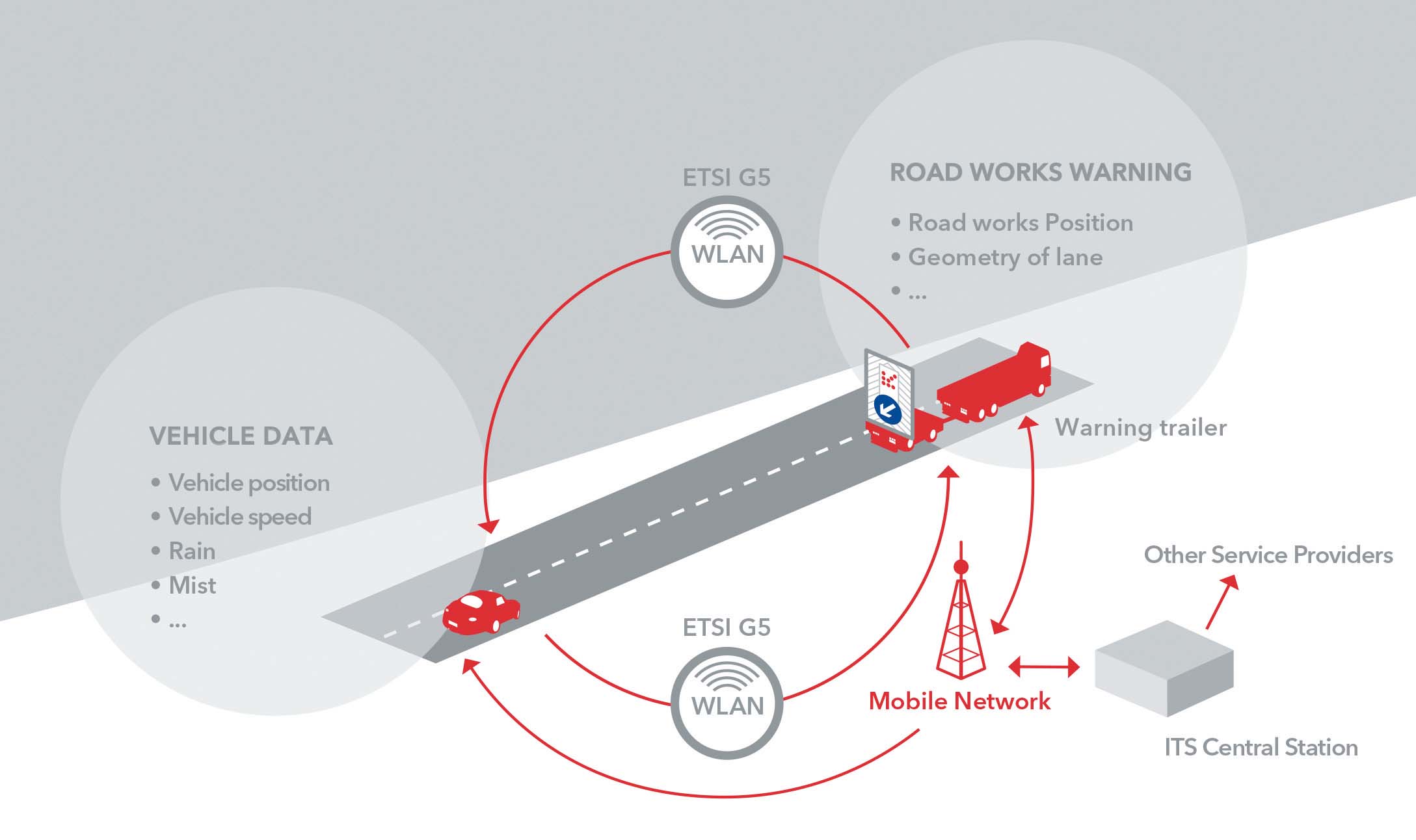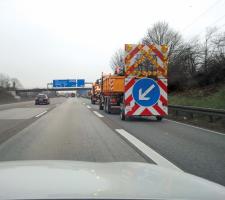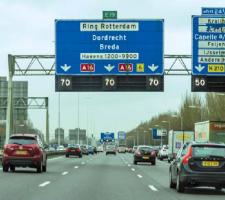
In the European C-ITS Corridor project, authorities from three countries are working with the automotive industry on the deployment of Cooperative (V2X) Systems.
Cooperative Intelligent Transport Systems/Services (C-ITS) has the potential to improve road safety, transport efficiency and environmentally friendly mobility, as well as creating additional services and new business models. A set of international standards have been developed to provide the technical basis for the deployment of Cooperative ITS.
In June 2013 German, Dutch and Austrian transport ministries signed an MoU to start a joint action to produce a timetable for the implementation of the first cooperative applications on motorways; specifying a common interface to the vehicles in the three countries; and the implementation of roadside facilities for collaborative applications.
A motorway corridor from Rotterdam in the Netherlands, via Frankfurt in Germany to the Austrian capital Vienna was chosen for Europe’s first trans-national first deployment - the C-ITS Corridor.
Two applications
The countries agreed on the introduction of two cooperative ITS applications, which are part of the ‘Day 1’ services (as defined by the Amsterdam Group) and considered highly relevant in regards to road safety, traffic efficiency and the dissemination of further C-ITS technologies and services.
The first service focusses on in-car information about roadworks, adjusted to the needs of approaching drivers using a road-works safety trailer equipped with GPS and a communication system. In ‘stand-alone mode’ (that is without a connection to the backend system), the trailer knows its own position, sign configuration, which lane is closed and current speed limit in the roadworks zone. This information can be transmitted to vehicles via WiFi-p (ETSI ITS G5), using an event triggered DENM (Decentralised Environmental Notification Message).
There is the option to include the providing journey times but in order to keep things simple at the start, this is not in the scope of the current project.
In normal operation mode, the so-called ‘Basic Service’, the trailer continuously sends its position to the back office, where additional information about the roadworks (layout, lane configuration and speed limits) can be looked up. Updated information is sent back to the trailer, which can then transmit an enhanced DENM. The back office can also provide the latest roadworks information to all traffic service providers through a single point of access such as Germany’s Mobility Data Marketplace (MDM) and the National Data Warehouse (NDW) in the Netherlands. Dissemination via short-ranged ETSI G5 serves as a local hazard warning for drivers approaching a roadworks site while notification of roadworks locations over other networks can inform strategic routing advice.
Main benefits are increased safety for both site workers and drivers, real-time information about the location of roadworks and reliable information for roadworks planning and management.
Those messages can be received by safety trailers or roadside units and can be anonymously forwarded to the traffic control centre. This will inform route planning (and thereby environmental benefits) and network control as well as improve traffic safety and incident management. And as the C-ITS system is based on short range communication using ETSI G5, it provides low latency safety announcements - both V2V and V2I.
Cross-border
The effective operation of the C-ITS Corridor with its different but interoperable technical solutions across three countries has been a particular challenge because each country has its own political and legal constraints, as well as different conditions in terms of infrastructure for cooperative systems. This leads to different conception and realisation procedures for the C-ITS Corridor in each country, while the overall objective is interoperable services across all countries and all vehicle brands.
In Germany, both public and industrial partners are involved, with the development and introduction of the services carried out in a multistage iterative process led by the German Federal Ministry of Transport and Digital Infrastructure (BMVI). The motorway operator of the federal state of Hesse carries out the initial development and testing of the new technology. Hessen Mobil is responsible for the prototype development of the Road Works Safety Trailer and the enhancements of the traffic control centre.Once the system specification and predevelopment phase are finalised, a six-month pilot will start in Hesse to thoroughly test the various operational processes and organisational structures in order to map roles and responsibilities. After that there will be a roll-out in five other German federal states along the C-ITS Corridor followed by the remaining federal states.
In Austria the project ECo-AT (European Corridor - Austrian Testbed for Cooperative Systems) is co-funded by the Austrian Federal Government and is responsible for the joint corridor deployment. Led by
In the ‘specification definition and testing phase’ the system is specified and a living lab for testing is set up - the final set of specification documents is planned for release in late 2016. In the deployment phase, ASFINAG will verify the first phase results and deploy the Austrian part of the corridor and further sections of the motorway and expressway network from 2016 onwards.
In 2013 the Netherlands announced the ‘Better informed on the road’ action programme which sees the private sector, public authorities and knowledge institutes cooperate to develop the services required for road traffic management and traffic/travel information. It outlines a 10-year strategic course of action aimed at providing continuity and reassurance for all stakeholders.
Several C-ITS projects are ongoing in the Netherlands within this framework, and others are planned. So-called ‘tables’ were established, to discuss common issues of these projects.
For the Dutch part of the C-ITS Corridor,
In the Netherlands a special challenge is the consistency of information from the new cooperative and already existing systems, in particular the established motorway management systems with gantries on about 40% of the total Dutch motorway network.
In spite of national views on the C-ITS Corridor project, the three countries follow the objective of a consistent cross-border system with coordination between ministries and road operators ensured by strategic and operational level teams.
Moreover, the project works closely with international organisations, including standardisation bodies (CEN / ISO / ETSI), the European Commission and the Amsterdam Group.
The international dimension means responsibilities can no longer be defined at the national level. In particular, road operators and vehicle manufacturers are closely cooperating in the C-ITS Corridor, as mandatory standards and common interface specifications have to be defined for cooperative systems.
The impact of such process changes should not be underestimated.
Privacy and Security
Data protection and IT security present further challenges: while privacy ideally requires anonymity, IT security requires an authentication of messages. In order to take both aspects into account, the three countries have involved their respective experts and responsible institutions from an early stage.While the Road Works Warning is not affected by data protection laws, the inclusion of vehicle data in Cooperative Traffic Management requires suitable privacy protection. The current assumption is that because the transmitted data constitutes personally identifiable information it is therefore protected by privacy regulations so the user must give consent– which is subject to national laws.
The C-ITS Corridor is an important step towards Cooperative Systems in Europe, providing the road operators with emerging opportunities for traffic management. Together with industry partners such as the Car-2-Car Communication Consortium, a technological basis is being created to establish new roles and responsibilities as well as further applications, such as emergency vehicle warnings, end-of-traffic-jam alerts or broken down vehicle warnings. It is expected that costs and benefits of Cooperative Systems will be in a favourable ratio in foreseeable future, so that more and more vehicles and transport infrastructure will be equipped with the appropriate technology. In this way Cooperative Systems will gradually move into the everyday life of traffic participants and will be taken for granted as car radios are today.
- About the Authors: This article is a collaboration between Manfred Harrer, Dr. Christine Lotz-Keens, Helge Molin, Frans op de Bleek, Gerd Rigelhuth, Konstantin saver and Fred Verqeij.















